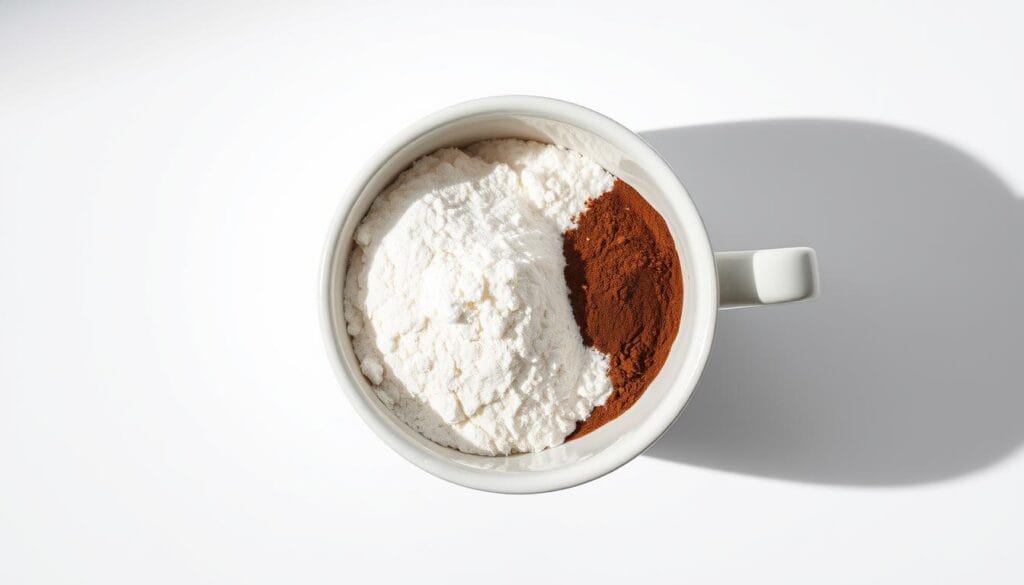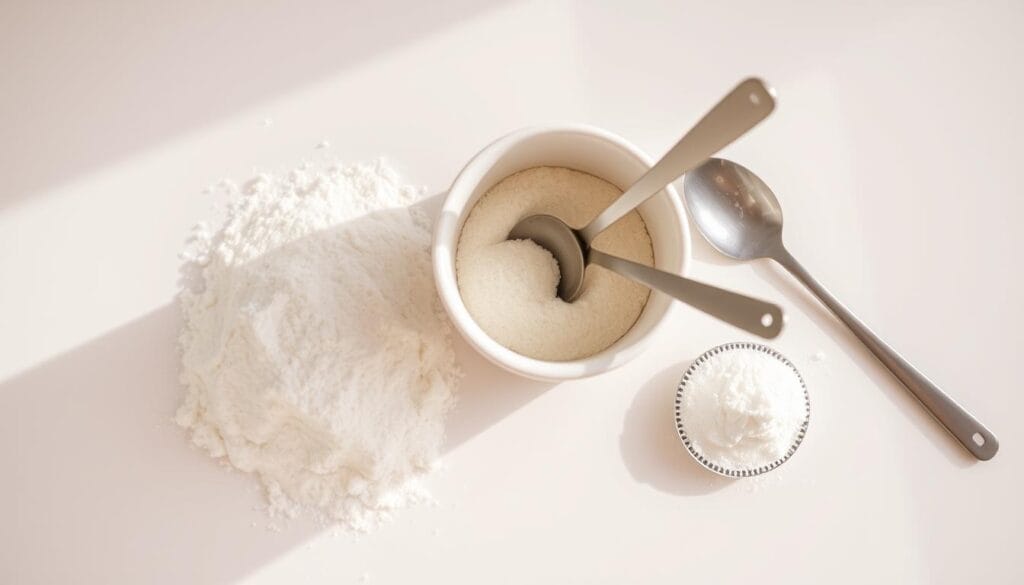Have you ever craved a delicious, moist cake but didn’t want to spend hours in the kitchen? This3-ingredient mug cake no egg recipe is here to save the day! It’s the perfect solution for sudden cravings, requiring just a few simple ingredients and a microwave.
What makes this recipe stand out? It’s incredibly convenient. With a microwave, you can whip up a fluffy, flavorful treat in just a few minutes. Plus, it’s budget-friendly, costing around $0.70 per serving. Whether you’re a busy student or someone looking for a quick dessert, this recipe is a lifesaver.
The best part? The detailed instructions and testing ensure your cake turns out perfectly every time. Stay tuned for tips on ingredients, microwave techniques, and creative flavor variations to make your mug cake truly special.
Table of Contents
Introduction to the no egg Delight
Imagine indulging in a soft, flavorful cake without the hassle of traditional baking. This 3-ingredient mug cake no egg offers a game-changing solution for dessert lovers. Unlike previous recipes that often resulted in dense or overcooked treats, this version has been perfected through professional testing to deliver a light and fluffy texture every time.
What Makes This Recipe Special
The secret lies in its innovative approach. By eliminating eggs and balancing just a few key ingredients like flour, milk, and sugar, this recipe achieves a moist and satisfying dessert. The absence of eggs doesn’t compromise flavor or texture—instead, it opens up possibilities for those with dietary restrictions or preferences.
The Benefits of a Quick Mug Cake
Time is precious, and this microwave mug cake cooks in just a few minutes. It’s not just about speed; it’s also cost-effective, with each serving costing around $0.70. Whether you’re satisfying a sudden craving or preparing a quick dessert, this recipe adapts to your needs effortlessly.

The convenience extends beyond cooking time. With a microwave and a microwave-safe mug, you can enjoy a freshly baked treat without any special equipment. This recipe is a testament to simplicity and efficiency, proving that quick desserts can be both delicious and satisfying.
Essential Ingredients and Equipment
Creating a delicious egg-free mug cake starts with the right ingredients and tools. This section will guide you through the must-haves to ensure your treat turns out perfectly every time.
Mug Cake Must-Haves
Your recipe relies on a few simple yet vital components. Here’s what you need:
- Core Ingredients: All-purpose flour, milk, and sugar form the base. These provide structure, moisture, and sweetness.
- Dry Ingredients: Flour and baking powder are essential for rise and texture. Ensure your baking powder is fresh for the best results.
- Wet Ingredients: Milk and oil add moisture and tenderness. You can opt for dairy-free milk for a non-dairy version.
For added flavor, consider including chocolate chips or a pinch of salt.
Microwave and Mug Selection Tips
Your equipment plays a crucial role in even cooking. Here’s how to choose the right tools:
- Mug Choice: Use a wide, shallow, 8-ounce microwave-safe mug. This ensures even cooking and prevents hot spots.
- Microwave Settings: Adjust cooking time based on your microwave’s wattage. Lower wattage may need a few more seconds.
- Measurement Matters: Accurate measurements are key. Use a digital scale for precise amounts.
Fresh ingredients, especially baking powder, are vital for a light texture.

“The quality of your ingredients directly impacts the final result. Fresh and pure components ensure a moist and flavorful cake.”
Mixing Simple Ingredients for Success
Mixing the ingredients for your mug cake is where the magic begins. It’s all about creating a smooth, even batter that cooks perfectly in the microwave. Let’s break it down step by step.
Dry Ingredients and Their Role
Start by combining your dry ingredients: flour, sugar, and baking powder. Flour provides structure, sugar adds sweetness, and baking powder ensures the cake rises. Sift or whisk these ingredients in the mug to remove any lumps and ensure even distribution.
Combining Wet Ingredients Effectively
Next, add your wet ingredients—milk and oil—into the well you’ve created in the dry mix. Fold everything together gently, scraping the sides of the mug to incorporate all ingredients evenly. Avoid overmixing, as it can lead to a dense texture.
| Ingredient | Role in the Recipe |
|---|---|
| Flour | Provides structure and texture |
| Sugar | Adds sweetness |
| Baking Powder | Ensures the cake rises |
A well-mixed batter ensures even cooking and a light texture. Remember, gentle folding is key to a fluffy mug cake!

Step-by-Step Mug Cake Baking Instructions
Ready to bake your perfect mug cake? Follow these easy steps to ensure your treat turns out light and delicious every time.
Proper Mixing Techniques
Start by combining your dry ingredients—flour, sugar, and baking powder—in the mug. Mix well to avoid lumps. Next, add milk and oil, gently folding until smooth. Be careful not to overmix, as it can make the cake dense.
Baking Time: Ensuring a Moist Texture
Cooking time varies by microwave wattage. For an 800W microwave, cook for 2 minutes. At 950W, 1 minute 15 seconds is ideal. After cooking, let the cake rest for a minute. Gently press the top; it should feel soft but firm. If it’s too wet, cook for a few more seconds.
| Step | Action |
|---|---|
| 1 | Mix dry ingredients |
| 2 | Add wet ingredients, mix gently |
| 3 | Cook in microwave (time based on wattage) |
| 4 | Rest, then serve |
By following these steps, you’ll achieve a moist, fluffy mug cake every time. Enjoy your quick and delicious treat!
Mastering the 3 ingredient mug cake no egg Experience
Understanding your microwave’s power is crucial for perfect results. Adjusting cook time based on wattage ensures your cake is cooked to perfection without overcooking.
Adapting to Your Microwave Wattage
Microwave wattage significantly impacts cooking time. Higher wattage means shorter cooking times, while lower wattage requires a bit more patience. Here’s a guide to get it just right:
| Microwave Wattage | Cooking Time |
|---|---|
| 600W | 2 minutes 30 seconds |
| 800W | 2 minutes |
| 1000W | 1 minute 20 seconds |
| 1200W | 1 minute |
For example, a 1200W microwave cooks the cake in just 1 minute, while a 600W microwave needs 2 minutes 30 seconds. Always test the cake after the recommended time by gently pressing the top—it should feel soft but firm. If it’s too wet, cook for an additional 10-15 seconds and check again.
Practical tips for even heating include rotating the mug every 30 seconds and using the defrost setting for lower wattage microwaves. Always use a microwave-safe mug and ensure it’s large enough to prevent overflow. With these adjustments, you’ll consistently achieve a moist and fluffy texture that’s hard to resist.
Flavor Variations and Creative Twists
Take your mug cake to the next level with exciting flavor combinations and creative add-ins. Whether you’re in the mood for something classic or adventurous, these ideas will inspire you to experiment and find your new favorite flavor.
Chocolate and Funfetti Options
Indulge in a chocolate lover’s dream by adding cocoa powder or chocolate chips to the batter. For a playful twist, sprinkle some funfetti on top before cooking for a colorful surprise. These additions create a treat that’s both rich and fun.
Adding Fruits and Nuts for Extra Texture
Fresh raspberries or blueberries add natural sweetness and a burst of freshness. Chopped nuts like almonds or walnuts provide a satisfying crunch. These elements enhance both flavor and texture, making each bite more enjoyable.
For those looking to make the recipe vegan or gluten-free, consider substituting all-purpose flour with a gluten-free blend and using non-dairy milk. These adjustments maintain the recipe’s convenience while catering to different dietary needs.
With these simple tweaks, your mug cake can be tailored to any taste. Whether you’re adding chocolate chips, fresh fruit, or nuts, each variation keeps the recipe quick and convenient—perfect for any craving.
Time Management and Microwave Cooking Tips
Mastering the art of microwave cooking is essential for achieving the perfect texture in your mug cake. Proper time management ensures your treat is fluffy and moist, avoiding any sogginess or overcooking. Let’s explore how to adjust your cooking time based on your microwave’s performance for the best results.
Adjusting Cook Times for Different Microwaves
Your microwave’s wattage plays a significant role in cooking time. Here’s a quick guide to help you get it right:
- 800W: Cook for 2 minutes.
- 1000W: 1 minute 15 seconds is ideal.
- 1200W: Just 1 minute is enough.
- 1800W: Use 45 seconds for the perfect bake.
Always check the cake after the recommended time by gently pressing the top. If it feels too wet, add 10-15 seconds more and check again. This method ensures your cake is cooked to perfection without overdoing it.
Remember, using a microwave-safe mug is crucial for safety and even heating. By adjusting your cooking time based on wattage and monitoring the cake closely, you’ll consistently enjoy a delicious, fluffy treat every time.
Ingredient Substitutions and Dietary Modifications
Customizing your mug cake to fit various dietary preferences is simple and effective. Whether you’re vegan, gluten-free, or dairy-free, this recipe adapts effortlessly to your needs.
Vegan, Gluten-Free, and Dairy-Free Options
For a vegan version, replace dairy milk with almond, soy, or oat milk. Swap all-purpose flour with a 1:1 gluten-free blend for a gluten-free option. These substitutions maintain the cake’s moisture and flavor while catering to different dietary requirements.
Refined Sugar Alternatives and Oil Substitutes
Consider using coconut sugar instead of refined sugar for a healthier choice. You can also substitute oil with applesauce to reduce fat content. These changes subtly alter the texture and flavor, keeping the cake delicious and moist.
| Original Ingredient | Substitution | Notes |
|---|---|---|
| Flour | Gluten-free flour blend | Maintains structure without gluten |
| Milk | Non-dairy milk (almond, soy, oat) | Ensures dairy-free without compromising moisture |
| Sugar | Coconut sugar | Provides a slightly caramel flavor |
| Oil | Applesauce | Reduces fat, adds natural sweetness |
These substitutions allow you to enjoy a delicious mug cake tailored to your dietary preferences. Always measure substitute ingredients accurately for the best results.
Conclusion
With just a few simple steps and minimal ingredients, you can satisfy your sweet tooth without any hassle. This mug cake no egg recipe has been rigorously tested to ensure perfection, offering a light and fluffy texture every time. At just $0.70 per serving, it’s not only delicious but also budget-friendly.
Whether you’re adjusting for your microwave’s wattage or experimenting with flavors like chocolate chips or fresh fruit, this recipe adapts to your needs. It’s perfect for quick cravings, requiring just a minute or two in the microwave. Plus, with options for gluten-free or dairy-free versions, everyone can enjoy this treat.
What are you waiting for? Try this easy mug cake recipe today and share your thoughts in the comments. It’s the perfect way to indulge in a guilt-free, delicious dessert any time of the day!

